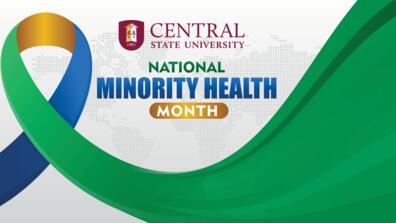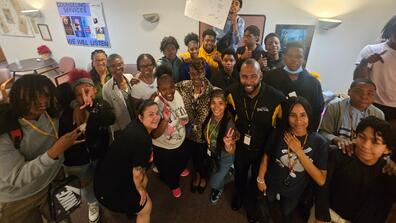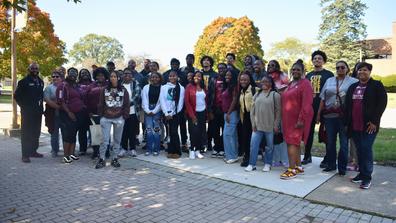
We are one: Supporting mental health equity at Central State and beyond

Editor's note: This column by Traci Bell-Thomas, the newly elected President of the Central State University National Alumni Association, is part of our Minority Mental Health Month series.
Maintaining positive mental health in Black, Indigenous, and People of Color (BIPOC) communities has become a prevalent subject over the past few years. And the importance of “preserving one’s peace” is a constant topic of humor, yet has a level of seriousness whether amongst friends, family, at work, and on social media. Mental health concerns are real and affect many, including myself.

I’ve learned that when things go wrong, as they sometimes will in traumatic or high-stress circumstances, I enter an autopilot “fixer” mode. I work on trying to resolve issues for myself (it’s called self-preservation) and those I care for. In too many instances, I’ve stressed myself and others out and have found myself in a state of poor physical and emotional health. As a woman of color, if you know you know (IYKYK), this will lead to poor health outcomes, including having anxiety or depression, experiencing poor cardiovascular health, or worse — a stroke.
Because I work in health and human services, focusing on reducing health disparities for Black, brown and underserved communities in Ohio, I understand the importance of ensuring resources and support services are provided to those most in need. Knowledge is power, and in recognition of Minority Mental Health Month, I am sharing state and national resources with our Central State University family to use as you deem necessary, or to pass on to help others.
Here are a few interesting facts:
The National Institute of Mental Health reports, “Most mental illness goes untreated, especially in communities of color. Fifty-two percent of [w]hites with any mental illness (AMI) received mental health services in 2020, compared to 37.1% of Blacks and 35% of Hispanics.” The institute also reported that 52.9 million people, nearly one in five U.S. adults, lived with a mental illness in 2020. And most mental illnesses, especially in communities of color, go untreated.
The National Alliance on Mental Illness (NAMI) shares that factors like socioeconomic disparities, including lacking health insurance and poor culturally competent healthcare experiences, are barriers to good mental health experiences/outcomes. Additionally, they’ve called out the stigma that exists in our communities, where experiencing and sharing one’s mental illness is a sign of weakness or shame. NAMI has done a yeoman’s job in breaking down barriers and aiding individuals to speak their truths while providing crucial resources for treatment.
The Ohio Department of Medicaid provides its members with access to behavioral health services, including counseling, medications for mental health and substance use disorders, outpatient treatment, and more. The department also has staff on-site working a toll-free hotline (800-324-8680) who can answer questions regarding eligibility, services, and coverage.
How many of us have a personal connection with someone who’s endured a crisis that you believe goes beyond the type of help you can provide? Prevention is imperative, and when it comes to suicide prevention, the Ohio Department of Mental Health & Addiction Services (OMHAS) has its 988 hotline to quickly respond to those in need while providing community-based services and supports. OMHAS focuses on building support services based on four tenets: connecting, responding, stabilizing, and thriving, to ensure all Ohioans receive assistance before an emergency occurs. Always dial 911 for immediate emergencies.
In 1987, the Ohio Commission on Minority Health became the first freestanding state agency in the United States to develop a concerted approach to address the disparity that exists between the health status of minority and non-minority populations. While the commission has focused on all health disparities of minority populations, they have consistently emphasized the importance of educating policymakers and the public on barriers to achieving health equity, including the social determinants of health (SDOH). These include safe living spaces, access to healthy food, employment opportunities, education, transportation, etc. The commission partners with national and local organizations in recognizing the importance of equitable, accessible, and culturally responsive mental healthcare.
Ultimately, we each have a responsibility to ourselves and our communities in addressing mental health in BIPOC communities head-on. How can we do this? First, by recognizing there’s a problem, speaking truth to power, asking for help, listening to our inner voices and the voices of others when they are asking for help, seeking out resources, sharing with others who can help in severe circumstances, exercising self-care AND self-love, and being kind to others, especially those throughout our Central State University campus community. You never know how your positive words of encouragement will impact someone during their time of need.
Most importantly, if you see something, say something. Don’t just stand by in the background, preparing to watch a train wreck. Think about how you could help someone else as you would want someone to help you or one of your loved ones. This is how we can collectively build a stronger community of care. Remember: We are family, we are Central, we are one! #FGFCFS
Mental health resources:
National Institute of Mental Health
Ohio Department of Mental Health and Addiction Services
Ohio Department of Mental Health and Addiction Services provider search


